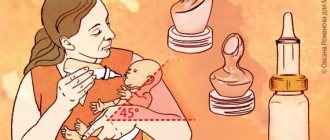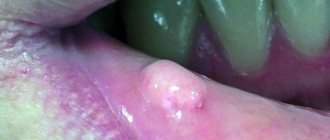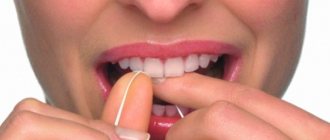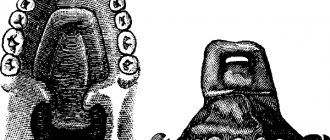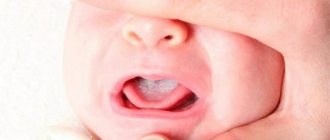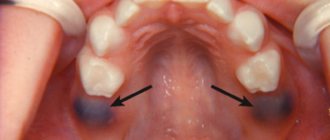Home|Facial malformations (cleft lip and palate)|Cleft palate (cleft palate)
Congenital defect of the hard and soft palate (cleft palate pathology) is a common facial malformation in infants. About a hundred babies are born every day in the world with this anomaly, most of whom are boys. It manifests itself as a rupture in the middle part connecting the oral cavity with the nasal cavity. Half of the children with this defect have a cleft lip defect. With timely treatment, cracks in the palate of a child are not dangerous to the life and health of the baby. The Towards Life project allows you to receive qualified medical assistance in correcting such defects free of charge.
Causes of cleft palate formation in humans
Experts do not have a consensus on the question of why children are born with a cleft palate. The appearance of the defect is associated with the presence of one or more provoking factors:
- inferiority of the germ cells of the parents: age over 40 years, hereditary gene mutations;
- infections and chronic diseases of the mother: rubella, chicken pox, herpes, syphilis, chlamydia, etc.;
- chemical intoxication: alcohol, drugs, smoking, chemicals, etc.;
- physical impact: amniotic fluid pressure, body overheating, radiation, falls, blows to the stomach, etc.
Often the cause of cleft palate is a metabolic disorder in the early stages of pregnancy, when it is accompanied by a lack of vitamins and minerals, toxicosis, lack of oxygen, and the threat of miscarriage. Taking antibiotics, sleeping pills and sedatives, medications for thyroid diseases, tumors, and arthritis can provoke a cleft palate in newborns. Psychological factors increase the risk of developing a defect: stress, prolonged experiences, lack of rest.
Types and manifestations of anomalies
The defect in newborns is manifested by a complete cleft of the soft and hard palate, passing through, or a small crack only in the soft tissues. According to the degree of bifurcation, the defect is classified into:
- complete – with splitting of soft and hard tissues up to the incisive foramen;
- incomplete - with a cleft only in the soft palate or with partial cleft of the hard palate;
- through – one- or two-sided clefts of the hard and soft palate with the inclusion of the alveolar process;
- hidden - the gap cuts only the muscles while preserving the oral mucosa.
“Cleft palate” in newborns, in addition to a cosmetic defect, is accompanied by a number of symptoms indicating disorders of the vital functions of the body. From the moment the baby is born, disturbances in sucking and swallowing of food appear. Shallow breathing develops, leading to oxygen deficiency and a tendency to inflammation of the middle ear, which negatively affects hearing. With the active growth of the baby, disorders of the speech apparatus (pronunciation of sounds through the nose) and delayed development of all body structures are detected.
Features of the structure of the oral cavity
The human sky has two components:
- The hard section, which has a concave shape, is formed by a bone plate.
- Fibrous or mucous membrane. The maximum number of nerve endings is concentrated in this part of the palate.
It is the fibrous part that bears the brunt of the blow when it comes into contact with solid objects and hot liquids, food, and cigarette smoke. In addition, the palate is part of the articulatory apparatus; in other words, it is directly involved in the formation of sounds. This organ is also responsible for the passage of inhaled and exhaled air, including tobacco smoke.
Diagnosis of the defect
The intrauterine development of the fetal facial bones suggests their fusion at the 7-8th week of pregnancy. The formation of the oral and nasal cavities occurs in parallel. Disruption of these processes can become a turning point in normal development, causing abnormalities, and the cause of cleft palate in children. By 2 months, the embryo’s upper jaw is finally formed from halves growing towards each other. A delay in their fusion leads to a defect that is diagnosed in the womb.
A routine ultrasound examination reveals the defect at 14-16 weeks of pregnancy. The volume, shape of the lesion and the complexity of the disease can only be assessed after the baby is born. The diagnosis of “cleft palate” in a newborn child is clarified by examination of the pharynx and a number of additional studies. Their goal is to determine possible pathologies of skull development, breathing disorders, smell, hearing and sound production.
Leukoplakia
With this disease, it is not only clearly visible how the palate is swollen, but also changes in the tissue of the mucous membrane. This can happen due to constant consumption of too cold or hot food, constant trauma to the oral cavity. In some cases, pathology appears during treatment with galvanic currents. This is possible after installing metal fillings or crowns.
Sometimes, long-term smokers develop a disease called Tappeiner's leukoplakia. This pathology does not cause much discomfort, but in any case it is a precancerous condition. The treatment method completely depends on the stage and cause of the disease, since leukoplakia is not a separate pathology.
We invite you to familiarize yourself with Non-contact prosthetics - what is dental prosthetics without grinding?
Conservative treatment involves relieving inflammation. Then, if necessary, the sharp edges of the teeth must be sanded down and/or fillings must be replaced. Vitamin A and oil-based compresses with vitamins are often used. It is recommended to drink vitamin C, coenzyme Q10, B3 and others, which will speed up the healing process of the epithelium.
What should parents of a child with such an anomaly do?
The main thing is not to panic at the thought, my child has a cleft palate, and not to try to terminate the pregnancy. You shouldn’t risk the mother’s health by postponing the birth of a baby because of a defect that can be successfully treated with modern surgery. Abortion is too high a price, especially if the cause of the defect is hereditary, and it may appear during the next pregnancy. Timely surgical treatment of congenital cleft palate makes this anomaly safe for the life and health of children.
It is important to seek qualified medical help from specialists in time to correct the defect and prevent the development of numerous complications, including:
- respiratory failure leading to hypoxia (lack of oxygen);
- frequent infectious and colds that weaken the immune system;
- speech and hearing disorders;
- delayed growth and development of the jaw.
Prevention of infectious lesions of the upper palate
It is easier to prevent inflammation of the palate than to cure its advanced stage. To do this you need to do the following:
- Limit the intake of solid foods - crackers, caramel, chips, lollipops, cookies. They can accidentally scratch the oral mucosa.
- Wash vegetables and fruits thoroughly. By consuming dirty foods, you can introduce infection into wounds and scratches on the oral mucosa, which can lead to the development of inflammation.
- Eliminate excessively cold and hot foods from your diet so that they do not burn the soft tissues in your mouth. This rule must be followed if the palate is already inflamed.
- Stop drinking sweet soda, as it irritates the oral mucosa. Strong alcohol has the same effect.
- Brush your teeth regularly. Brushing your teeth twice a day will not only protect against caries, but also prevent bleeding gums and the appearance of swelling near the uvula. You should also rinse your mouth after every meal, especially if your palate is already swollen.
- Constantly strengthen your immune system. You need to exercise, eat natural foods, plan your diet wisely, ensure regular good sleep and monitor the replenishment of vitamins and microelements.
- Treat your teeth regularly. To make your teeth strong, it is not enough to brush them daily and eat right. In addition, you should visit the dentist 2 times a year to undergo preventive examinations, remove tartar and plaque, and promptly treat caries and gingivitis (gum inflammation).
- Consult a doctor for any symptoms of dental diseases and pathologies of the ENT organs: if the throat turns red, the tonsils become swollen, signs of inflammation begin to be felt, wounds, ulcers and swelling appear in the mouth, and pain occurs in the palate.
- Monitor the condition of children's teeth. This rule applies to parents. It is worth explaining to your child that you should not put your hands or dirty objects in your mouth. Explain why exactly you shouldn’t do this.
Every person should take care of their oral health. Maintaining immunity, proper nutrition, good hygiene and timely visits to the dentist will help completely eliminate the risk of developing diseases of the palate and the appearance of pain in this area. If the inflammatory process has already begun, you should urgently consult a doctor and follow all his treatment recommendations.
How and where to treat a cleft palate?
Cleft palate surgery and cosmetic facial plastic surgery can eliminate external defects and restore the functionality of the oral and nasal cavities in a newborn (questionable, the operation is performed at the age of two years).
During the surgical operation, the palatine and pharyngeal muscles are connected in the correct position, the integrity, normal shape and functioning of all structures are restored. The extent of surgical interventions and the appropriate age for this are determined by the type of anomaly and the complexity of the case. After a thorough examination of the baby by the surgeon, one of the treatment tactics for children with cleft palate is selected:
- Uranoplasty (corrective surgery) from the age of 2 years – for incomplete clefts in children with regular upper jaw dentition.
- Uranoplasty at 4-6 years of age with preoperative orthodontic therapy - with a narrowed upper jaw and clefting, including the alveolar process.
- Two-stage correction (soft tissue plastic surgery with narrowing of the pharynx and, 6-8 months later, surgery on the hard palate with the alveolar process with simultaneous bone grafting).
Stages of uranoplasty
Before surgery, your baby needs to learn how to feed from a spoon. Sucking after surgery for a cleft soft and hard palate in a child causes pain, impairs wound healing and scar formation. The correction is performed under general anesthesia due to the proximity of the airways and the need for complete immobility of the patient. If it is impossible to close the gap with local tissues, plastic surgery is performed with flaps taken from the cheeks or tongue. Repeated surgical interventions are possible no earlier than six months later, necessary to restore tissue and blood supply.
The operation for cleft of the hard and soft palate is carried out in several stages:
- The peeling away of plastic material on both sides of a gap to close the hole.
- Lengthening of soft tissues by cutting off the mucous membrane of the nasal cavity.
- Stitching the gap at the midline.
- Reducing the pharynx in the middle section by moving its lateral tissues to the middle.
- Step-by-step suturing (first on the nasal mucosa, then on the muscle tissue and oral mucosa) with treatment with an antiseptic solution.
- Attaching a plate that protects against infection.
Treatment
The consequences of mechanical damage to the mucous membrane of the palate can be eliminated by rinsing the oral cavity with recommended compositions, for example, decoctions of various herbs; a solution based on iodine and salt, propolis works well. During treatment, you should refrain from eating solid food, there is a possibility of re-damage to the problem area. In such cases, doctors prescribe the use of targeted medications.
Treatment of tonsils does not involve independent actions. You should definitely consult a doctor and follow his instructions.
Ordinary stomatitis is a consequence of neglect of oral hygiene, so treatment of its mild form consists of following a diet, eliminating too cold and hot foods from the diet and regular rinsing with antiseptic agents.
Severe forms of stomatitis: aphthous, ulcerative, herpetic are characterized by massive damage to areas of the mucous membrane. In such cases, the help of dentists and therapists is required.
It is impossible to cure caries and pulpitis on your own. The sooner a patient seeks help from a dental clinic, the more successful the treatment will be and the less likely there are serious complications.
Rehabilitation period
The duration of postoperative rehabilitation is determined by the complexity of the case and the age of the patient.
If your child was born with a cleft palate, be prepared for the fact that his treatment will not be limited to surgery. The restoration of many functions depends on the quality of rehabilitation measures. In a hospital setting, they are aimed at improving the patient’s well-being, organizing proper nutrition, preventing disorders of the upper respiratory tract, and preventing infectious diseases and complications. In the future, the baby needs:
- additional treatment by an orthodontist for the correct relationship between the sizes of the dental arches and the development of the upper jaw;
- systematic observation by an otolaryngologist to monitor communication of the oral and nasal cavities, the functioning of the respiratory and hearing organs, and the prevention of ENT diseases;
- classes with a speech therapist to establish proper breathing, sound production, articulation, and correction of speech defects;
- consultation with a defectologist to identify possible developmental delays.
Symptoms
Symptoms of the problem largely depend on the cause of the inflammation. Pathologies of infectious, viral and fungal etiology manifest themselves in different ways.
Among the main signs characteristic of inflammation of the palate (regardless of the cause) are:
- pain of varying intensity;
- increase in the size of the sky;
- changes in the structure and color of the mucous membranes;
- discomfort while eating;
- rough palate syndrome.
Pain in the mouth is especially intense when infected with an infection. The lesions become red, swollen and inflamed
A significant increase in size of the area may indicate an allergic reaction. It occurs due to intolerance to food, medications or dental care products. Painful sensations are complemented by burning and itching. To relieve symptoms, it is recommended to take antihistamines.
Bleeding soft tissues indicate the introduction of bacterial flora into them. In this case, the symptom may be complemented by toothache.
Dangerous symptoms
Diseases that cause damage to the mucous structures of the mouth have a negative impact on overall health. Some symptoms should be a reason to see a doctor if the roof of your mouth hurts. The list of dangerous signs includes:
What to do if your cheek is swollen from a tooth
- loss of sensitivity of mucous structures;
- change in taste sensations;
- discomfort in the throat while swallowing (a symptom may indicate the development of a purulent sore throat);
- significant swelling of the mucous membranes;
- tooth decay;
- the presence of sores on the gums;
- seals with a modified structure, palpable on the tongue.
Help from the project “Towards Life”
The scope of rehabilitation activities, the number of doctors involved in the treatment, and the cost of cleft palate surgery in well-known medical centers should not diminish your determination to improve your child’s health. After consultation with specialists, you can do a significant part of the work to restore functions (breathing exercises, exercises to develop the speech apparatus, preventive measures, etc.) with your baby yourself at home. Your persistence and patience are an important component of success in treatment.
There is also an answer to the question of where surgery for congenital cleft palate is performed free of charge - in Yaroslavl. With the support of charitable organizations (Rusfond, “Beautiful Children in a Beautiful World”), we offer medical care from the best specialists without payment. To receive free surgical treatment from our maxillofacial surgeons: Doctor of Medical Sciences, Professor S.N. Bessonova and L.A. Eremeyshvili, you need to collect the necessary documents according to the list, send them for consideration and wait for the call for treatment.
You can make an appointment with a specialist by phone: 8 on weekdays from 9.00 to 19.00 Moscow time Or through the form on the website Sign up for a free consultation

